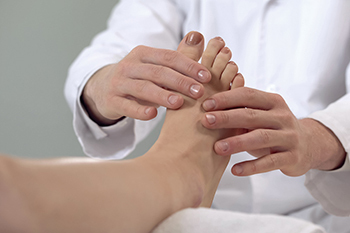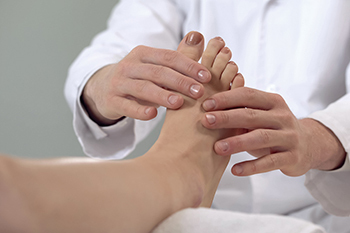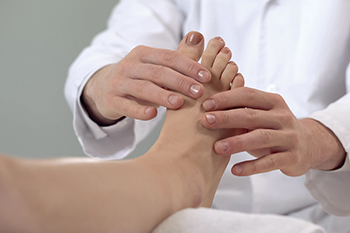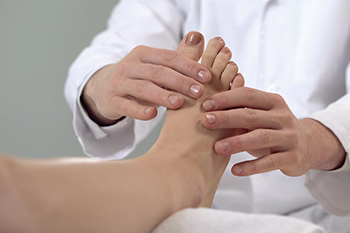Items filtered by date: September 2022
Metatarsal Stress Fractures

The foot is made up of tiny bones, called metatarsals. A metatarsal stress fracture is an acute fracture of one of these little bones. This usually occurs from overuse or poor foot mechanics. When bodies break down, they generally break down at the weakest point. In sports, stress fractures are caused by repetitive force over a long period of time. Metatarsal fractures can happen from wearing the wrong shoes, training on hard pavement and poor nutrition. These factors puts one at higher risk for developing stress fractures. Symptoms of metatarsal stress fractures are dull, underlying pain, that can be intermittent. One should not ignore pain of any sort. In fact, catching and treating pain early can help metatarsal stress fractures heal quicker than if ignored. If you feel you have sustained a stress fracture or have any other pain in your feet, it is suggested that you consult with a podiatrist who can diagnose the problem and get you back to full functioning as soon as possible.
Activities where too much pressure is put on the feet can cause stress fractures. To learn more, contact James Pak, DPM from California. Our doctor can provide the care you need to keep your pain free and on your feet.
Dealing with Stress Fractures of the Foot and Ankle
Stress fractures occur in the foot and ankle when muscles in these areas weaken from too much or too little use. The feet and ankles then lose support when walking or running from the impact of the ground. Since there is no protection, the bones receive the full impact of each step. Stress on the feet can cause cracks to form in the bones, thus creating stress fractures.
What Are Stress Fractures?
Stress fractures occur frequently in individuals whose daily activities cause great impact on the feet and ankles. Stress factors are most common among:
- Runners
- People affected with Osteoporosis
- Tennis or basketball players
- Gymnasts
- High impact workouts
Symptoms
Pain from the fractures occur in the area of the fractures and can be constant or intermittent. It will often cause sharp or dull pain with swelling and tenderness. Engaging in any kind of activity which involves high impact will aggravate pain.
If you have any questions please feel free to contact our office located in Anaheim, CA . We offer the newest diagnostic and treatment technologies for all your foot and ankle needs.
Why Do Bunions Develop?

There are some people who refer to bunions as a bone disorder. This foot condition is the result of a foot structure abnormality, and can be caused by genetic factors. Additionally, patients who choose to wear shoes that do not have adequate room for the toes to move freely in may notice a bunion is developing. It is defined as a bony protrusion on the side of the big toe, and in severe cases, may be large enough to shift the other toes toward each other. There may be existing medical conditions that may lead to getting a bunion. These can include having a low arch, rheumatoid arthritis, or possibly from having endured a foot injury. Common symptoms that affect many people with bunions can consist of redness, numbness, and there may be a burning sensation in the affected joint. Mild relief may come from wearing shoes that are larger which can accommodate the protrusion, and it may help to place a protective covering over the bunion. If you have a bunion, it is advised that you are under the care of a podiatrist who can offer you effective treatment options.
If you are suffering from bunion pain, contact James Pak, DPM of California. Our doctor can provide the care you need to keep you pain-free and on your feet.
What Is a Bunion?
Bunions are painful bony bumps that usually develop on the inside of the foot at the joint of the big toe. As the deformity increases over time, it may become painful to walk and wear shoes. Women are more likely to exacerbate existing bunions since they often wear tight, narrow shoes that shift their toes together. Bunion pain can be relieved by wearing wider shoes with enough room for the toes.
Causes
- Genetics – some people inherit feet that are more prone to bunion development
- Inflammatory Conditions - rheumatoid arthritis and polio may cause bunion development
Symptoms
- Redness and inflammation
- Pain and tenderness
- Callus or corns on the bump
- Restricted motion in the big toe
In order to diagnose your bunion, your podiatrist may ask about your medical history, symptoms, and general health. Your doctor might also order an x-ray to take a closer look at your feet. Nonsurgical treatment options include orthotics, padding, icing, changes in footwear, and medication. If nonsurgical treatments don’t alleviate your bunion pain, surgery may be necessary.
If you have any questions, please feel free to contact our office located in Anaheim, CA . We offer the newest diagnostic and treatment technologies for all your foot care needs.
Psoriatic Arthritis and Foot Conditions

Many individuals that suffer from psoriatic arthritis can develop three different kinds of common foot afflictions. Sometimes, before a diagnosis of psoriatic arthritis, an individual might even notice the onset of one of the following conditions. First, those with psoriatic arthritis can develop plantar fasciitis. This affliction occurs when the long band of tissue that runs along the arch of your foot (the plantar fascia) becomes strained and inflamed. This affliction is a common source of heel pain, particularly first thing in the morning. Second, those with psoriatic arthritis commonly develop Achilles tendonitis, which occurs when the tendon that runs between the heel and the calf muscle becomes inflamed. Heel pain is a typical symptom of this condition. Third, individuals living with psoriatic arthritis can commonly develop dactylitis, which can occur when a person’s toes become significantly and severely swollen. If you are living with psoriatic arthritis, take extra care of your feet. Leaving foot conditions like these unaddressed can create long term damage. Ensure that you are properly managing your psoriatic arthritis, and speak to a podiatrist. This foot specialist will be able to meet with you to assist you in maintaining the health of your feet.
Arthritis can be a difficult condition to live with. If you are seeking treatment, contact James Pak, DPM from California. Our doctor can provide the care you need to keep you pain-free and on your feet.
Arthritic Foot Care
Arthritis is a joint disorder that involves the inflammation of different joints in your body, such as those in your feet. Arthritis is often caused by a degenerative joint disease and causes mild to severe pain in all affected areas. In addition to this, swelling and stiffness in the affected joints can also be a common symptom of arthritis.
In many cases, wearing ill-fitting shoes can worsen the effects and pain of arthritis. Wearing shoes that have a lower heel and extra room can help your feet feel more comfortable. In cases of rheumatoid arthritis, the arch in your foot may become problematic. Buying shoes with proper arch support that contour to your feet can help immensely.
Alleviating Arthritic Pain
- Exercises that stretch the foot can prevent further pain and injury and increase mobility
- Most of the pain can be alleviated with anti-inflammatory drugs, heat, and topical medications
- Massages can help temporarily alleviate pain.
It is best to see your doctor for the treatment that is right for your needs and symptoms. Conditions vary, and a podiatrist can help you determine the right method of care for your feet.
If you have any questions, please feel free to contact our office located in Anaheim, CA . We offer the newest diagnostic tools and technology to treat your foot and ankle needs.
Various Reasons for Ankle Pain

There are several types of ankle disorders that people can experience. These include sprains, fractures, arthritis, and tendonitis. The function of the ankle is to stabilize the body by supporting the surrounding muscles, tendons, and ligaments. Research has shown that it is the most injured part of the body, and when hurt can negatively impact completing daily activities. An ankle sprain or fracture can happen from unexpectedly stepping off of a curb, causing the ligaments to twist beyond their normal range of motion. Additionally, ankle pain may happen from a sudden fall, with increased force on the ankle joint, often causing immediate and severe pain. There are several types of arthritis that can affect the ankle and can cause limited mobility. Osteoarthritis gradually develops, and can happen when the cartilage between the bones wears down. Having stiff joints may be the result of this type of arthritis. An autoimmune inflammatory disease can produce rheumatoid arthritis, and can attack the body’s healthy tissues. If an injury to the ankle has occurred, post-traumatic arthritis may develop from the stress, and joint stiffness may continue for years following the injury. If you have any type of ankle pain, it is strongly advised that you are under the care of a podiatrist who can effectively diagnose and treat ankle disorders.
Ankle pain can have many different causes and the pain may potentially be serious. If you have ankle pain, consult with James Pak, DPM from California. Our doctor will assess your condition and provide you with quality foot and ankle treatment.
Ankle pain is any condition that causes pain in the ankle. Due to the fact that the ankle consists of tendons, muscles, bones, and ligaments, ankle pain can come from a number of different conditions.
Causes
The most common causes of ankle pain include:
- Types of arthritis (rheumatoid, osteoarthritis, and gout)
- Ankle sprains
- Broken ankles
- Achilles tendinitis
- Achilles tendon rupture
- Stress fractures
- Tarsal tunnel syndrome
- Plantar fasciitis
Symptoms
Symptoms of ankle injury vary based upon the condition. Pain may include general pain and discomfort, swelling, aching, redness, bruising, burning or stabbing sensations, and/or loss of sensation.
Diagnosis
Due to the wide variety of potential causes of ankle pain, podiatrists will utilize a number of different methods to properly diagnose ankle pain. This can include asking for personal and family medical histories and of any recent injuries. Further diagnosis may include sensation tests, a physical examination, and potentially x-rays or other imaging tests.
Treatment
Just as the range of causes varies widely, so do treatments. Some more common treatments are rest, ice packs, keeping pressure off the foot, orthotics and braces, medication for inflammation and pain, and surgery.
If you have any questions, please feel free to contact our office located in Anaheim, CA . We offer the newest diagnostic and treatment technologies for all your foot care needs.

